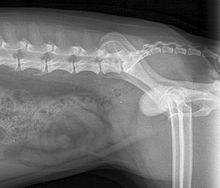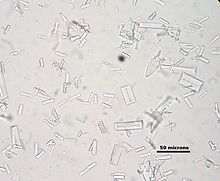Bladder stone (animal)



Bladder stones or uroliths are a common occurrence in animals, especially in domestic animals such as
Signs and symptoms
Bladder stones may cause blood in the urine (animal)in the (
Mechanism
Oversaturation of
The stones form around a nidus, which can consist of white blood cells, bacteria, and organic matrix mixed with crystals, or crystals alone. The nidus makes up about two to ten percent of the mass of the stone.[4] It is possible for the nidus to be made of a different type of crystal than the rest of the stone, also known as epitaxial growth.
Nutrition often plays a major role in the development of bladder stones. Sodium, calcium, phosphorus and potassium ratios and quantities play a large role in urinary health of animals. Research indicates that low dietary inclusion of potassium is associated with increased renal calcium excretion, which lowers urinary pH. By lowering urinary pH, the risk for development of calcium oxalate uroliths increases. By feeding proper amounts of calcium and potassium we avoid this issue, which is especially common in male cats.[5]
Diagnosis
When symptoms indicate bladder stones, the first step is usually to take an
Struvite stones

Struvite stones are also known as magnesium ammonium phosphate stones due to their chemical composition - MgNH4PO4·6H2O. Often there is a small amount of calcium phosphate present.[6] They form at a neutral to alkaline pH of the urine. Bacterial infections contribute to their formation by increasing the pH of the urine through the urease enzyme in dogs. More than 90 percent of dogs with struvite stones have an associated urease-producing bacterial infection in the urinary tract, but in cats struvite stones usually form in sterile urine.[7] The appearance of the stones vary from large solitary stones to multiple smaller stones. They can assume the shape of the bladder or urethra.

Dissolution of the struvite stones depends on acidification of the urine through diet or urinary acidifiers. Special diets for dissolution also have reduced protein, phosphorus, and magnesium, as well as increased salt to increase water consumption and dilute the urine. The diet needs to be fed exclusively, but it can only be fed for a few months total due to potential side effects. Contraindications to this diet include heart failure, liver failure, kidney failure, pancreatitis, hypertension (high blood pressure), and hypoalbuminemia (low serum albumin).[8] Prevention of struvite stones is with a similar diet with milder restrictions.
Certain dog breeds are predisposed to struvite stones, including
Calcium oxalate stones

Calcium oxalate stones form in an acidic to neutral urine. Two types naturally occur, calcium oxalate monohydrate, or whewellite (CaC2O4·H2O), and calcium oxalate dihydrate, or weddellite (CaC2O4·2H2O). Their appearance can be rough, smooth, spiculated (needle-like), or jackstone. Calcium oxalate stones form more readily in animals with hypercalcaemia, which can be caused by Addison's disease or certain types of cancer. Hypercalcaemia results in hypercalciuria, which can also be caused by Cushing's syndrome or hyperparathyroidism.
There is no recommended diet to dissolve calcium oxalate stones. For prevention a diet low in protein and oxalates and high in magnesium, phosphorus, and calcium is recommended. Increased dietary magnesium and phosphorus decreases the amount of calcium in the urine, and increased dietary calcium reduces absorption of oxalates from the intestines.[10] Potassium citrate has been recommended to prevent calcium oxalate stone formation because it forms a soluble complex with oxalates and promotes the formation of alkaline urine.[3]
Dog breeds possibly prone to calcium oxalate stones include
Frequency of struvite and calcium oxalate stones in cats
The Minnesota Urolith Center at the University of Minnesota College of Veterinary Medicine has done detailed analysis of uroliths from animals since 1981 and has noted changing trends in feline uroliths. In 1981, struvite stones were the most common type in cats, making up 78 percent of submitted samples, with only 2 percent comprising calcium oxalate stones. In the mid 1980s there was a substantial increase in the number of calcium oxalate samples, and between 1994 and 2002, 55 percent of feline stones were calcium oxalate and 33 percent were struvite. This may have been caused by the use of dissolution diets for struvite stones in cats and modification of other diets to prevent struvite crystal formation. These modifications predisposed to calcium oxalate crystal formation. However, in 2004, struvite stones once again surpassed calcium oxalate stones 44.9 percent to 44.3 percent, and in 2006, 50 percent of stones were struvite and 39 percent were calcium oxalate. This may have been due to the increased use of diets designed to prevent calcium oxalate crystal formation, which because of increased magnesium in the diet and decreased acidity of the urine help promote struvite crystal formation.[11]
Urethral plugs in cats are usually composed of struvite crystals and organic matter.[12]
Urate stones

Urate stones can be dissolved using a diet with reduced purines that alkalinizes and dilutes the urine. Allopurinol is used in dogs with altered purine metabolism to prevent the formation of uric acid. Feeding a diet high in purines while simultaneously administering allopurinol can result in the formation of xanthine (C5H4N4O2) stones.
Cystine stones
Calcium phosphate stones
Calcium phosphate, also known as hydroxyapatite (Ca10(PO4)6(OH)2), stones form in neutral to alkaline urine. They are usually smooth and round. Calcium phosphate is usually a component of struvite or calcium oxalate stones and is infrequently a pure stone. They form more readily with hypercalcaemia. Dog breeds possibly predisposed to calcium phosphate stone formation include Yorkshire Terriers, Miniature Schnauzers, and Cocker Spaniels.[3]
Silicate stones
Treatment
Reasons for treatment of bladder stones include recurring symptoms and risk of urinary tract obstruction. Some stones, including struvite and urate stones, can be dissolved using dietary modifications and/or medications. Calcium oxalate stones are not able to be dissolved and must be surgically removed.
To prevent recurrence of stones, special diets can be used for each type of stone. Increasing water consumption by the animal dilutes the urine, which prevents oversaturation of the urine with crystals.
References
- ^ "Dietary treatment of bladder stones". Clinical Nutrition Service at Cummings School. 2017-07-26. Retrieved 2020-02-08.
- ^ Giant tortoise cheats death Archived July 26, 2011, at the Wayback Machine ("Evening Express", Aberdeen, 31/01/2009)
- ^ ISBN 0-7216-6795-3.
- ^ a b "Urolithiasis: Overview". The Merck Veterinary Manual. 2006. Retrieved 2007-04-14.
- ^ PaBlack, N., Brenten, T., Neumann, K., & Zentek, J. (2014). Effects of potassium chloride and potassium bicarbonate in the diet on urinary pH and mineral excretion of adult cats. British Journal of Nutrition, 111(5), 785-797.
- ^ Buffington, Tony (2004). "Nutrition and Urolithiasis". Proceedings of the 29th World Congress of the World Small Animal Veterinary Association. Retrieved 2006-07-16.
- ^ Hoskins, Johnny D. (November 2006). "Feline Urolithiasis". DVM. Advanstar Communications: 6S–7S.
- ^ a b c d "Canine Urolithiasis". The Merck Veterinary Manual. 2006. Retrieved 2007-04-14.
- ^ ISBN 0-7216-4023-0.
- ^ a b c Zoran, Debra (2006). Role of Diet in Feline and Canine Urolithiasis.
- ^ Osborne, Carl A.; Lulich, Jody P. (February 2007). "Changing trends in composition of feline uroliths and urethral plugs". DVM. Advanstar Communications: 38–40.
- S2CID 33483919.
- PMID 16117063.
- ^ "Feline Urolithiasis and Feline Lower Urinary Tract Disease". The Merck Veterinary Manual. 2006. Retrieved 2007-04-14.
- ^ Team, Clinical Nutrition (2017-07-26). "Dietary treatment of bladder stones". Clinical Nutrition Service at Cummings School. Retrieved 2019-12-20.
- ^ "Struvite Bladder Stones in Dogs". vca_corporate. Retrieved 2019-12-20.
